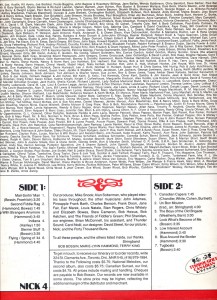It’s true. You can even be MY record producer, or at least an honorary one. All it takes is some money. But before you label me a total mercenary, read on…
You may have noticed these days the indie record/music scene is almost as big as the non-indie scene – if not in terms of dollars, then certainly in terms of the number of artists. In fact, there are undoubtedly more independents than acts signed to major labels. Everyone with three chords and a laptop is a musician nowadays. Democracy comes to the music biz!
Independently poor
The Internet played a large part in this, of course. Suddenly everyone was illegally sharing music and no one was buying. So labels would only sign sure moneymakers, forcing artists to make albums independently – i.e., paying to do it themselves. And becoming even poorer in the process. Sometimes they’d make the money back and even turn a tidy profit, but often they’d end up working at Timmie’s to pay the studio bills.
But the indie scene has actually been around a heck of a lot longer than the Internet. I like to say, jokingly, or semi-jokingly, that at one time it used to be called the folk scene.
Folk pioneers
That’s where my musical roots are. My old band Stringband has been called a pioneer of the indie record scene. What that means is we just couldn’t get any label to sign us all those eons ago. Most of the majors in Canada then were US subsidiaries, aiming at the big US market, and they all told us we were too folky and too Canadian. So we started our own label.
A generous fan funded our first album, done on the cheap, but we wanted a bigger budget for the second. So we borrowed an idea that was floating around: we asked fans to send us $5 up front (yeah, I’m talking the good old days; the horseless carriage had barely been invented), and we’d use the funds to make the album and then mail them a copy.
It worked! We briefly considered running off to Mexico with all those five-dollar bills – it was February – but in the end recorded our next two albums that way. A few other folk acts were doing the same thing, then more followed suit, and that model has since become commonplace in the indie scene.

Crowd pleaser
Now they call it crowdsourcing; we just called it asking fans to help. In fact, for our third album, I got the bright idea to title it Thanks to the Following, and we printed all the supporters’ names in tiny font starting on the front cover and almost completely covering the back.
If you decide to go this route, there are websites that can help you, such as http://www.kickstarter.com/, http://www.gofundme.com/ and others. Or you can do what I and many musicians do: contact your mailing list, and tell the fans you’re making a new CD.
Full support
Create multiple levels of support – e.g., see my fundraising pitch – and offer various perks. For example, my “entry” level is $20 to pre-order one CD; my top two levels include, among other goodies, an honorary producer credit on any song of the patron’s choice.
So “honorary producer” may not be quite like twiddling the controls at the recording console (more likely a computer these days) or telling the drummer to go easy on the high hat, but several devoted fans have chosen to support me this way, and I know many other artists with “angels” who have happily contributed to their recording projects. As the wise woman said, “You won’t know if you don’t ask.”
And — oh yeah — dear fans awaiting the new CDs, please be patient. I’m crowdsourcing as fast as I can!



